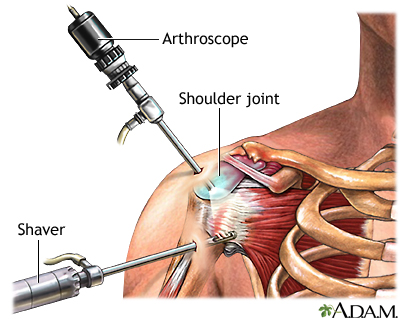Pregnancy SmartSiteTM
SLAP repair; SLAP lesion; Acromioplasty; Bankart repair; Labral repair; Bankart lesion; Shoulder repair; Shoulder surgery; Rotator cuff repair DefinitionShoulder arthroscopy is surgery that uses a tiny camera called an arthroscope to examine or repair the tissues inside or around your shoulder joint. The arthroscope is inserted through a small cut (incision) in your skin. DescriptionThe rotator cuff is a group of muscles and their tendons that form a cuff over the shoulder joint. These muscles and tendons hold the arm in the shoulder joint. This also helps the shoulder move in different directions. The tendons in the rotator cuff can tear when they are overused or injured. You will likely receive general anesthesia for this surgery. This means you will be asleep and unable to feel pain. Or, you may have regional anesthesia. Your arm and shoulder area will be numbed and as a result, you do not feel any pain. If you receive regional anesthesia, you will also be given medicine or general anesthesia to make you very sleepy during the operation. During the procedure, the surgeon:
Your surgeon may do one or more of these procedures during your operation: Rotator cuff repair:
Surgery for impingement syndrome:
Surgery for shoulder instability:
At the end of the surgery, the incisions will be closed with stitches and covered with a dressing (bandage). Most surgeons take pictures from the video monitor during the procedure to show you what they found and the repairs that were made. Your surgeon may need to do open surgery if there is a lot of damage. Open surgery means you will have a large incision so that the surgeon can get directly to your bones and tissues. Why the Procedure Is PerformedArthroscopy may be recommended for these shoulder problems:
RisksRisks of anesthesia and surgery in general are:
Risks of shoulder arthroscopy are:
Before the ProcedureTell your surgeon what medicines you are taking. This includes medicines, supplements, or herbs you bought without a prescription. During the 2 weeks before your surgery:
On the day of surgery:
After the ProcedureFollow any discharge and self-care instructions you are given. Recovery can take 1 to 6 months. You will probably have to wear a sling for the first week. If you had a lot of repair done, you may have to wear the sling longer. You may take medicine to control your pain. When you can return to work or play sports will depend on what your surgery involved. It can range from 1 week to several months. Physical therapy may help you regain motion and strength in your shoulder. The length of therapy will depend on what was done during your surgery. Outlook (Prognosis)Arthroscopy often results in less pain and stiffness, fewer complications, a shorter (if any) hospital stay, and faster recovery than open surgery. If you had a repair, your body needs time to heal, even after arthroscopic surgery, just as you would need time to recover from open surgery. Because of this, your recovery time may still be long. Surgery to fix a cartilage tear is usually done to make the shoulder more stable. Many people recover fully, and their shoulder stays stable. But some people may still have shoulder instability after arthroscopic repair. Using arthroscopy for rotator cuff repairs or tendinitis usually relieves the pain, but you may not regain all of your strength. ReferencesDeBerardino TM, Scordino LW. Shoulder arthroscopy. In: Miller MD, Thompson SR, eds. DeLee, Drez, & Miller's Orthopaedic Sports Medicine. 5th ed. Philadelphia, PA: Elsevier; 2020:chap 39. Phillips BB, Brolin TJ. Arthroscopy of the upper extremity. In: Azar FM, Beaty JH, eds. Campbell's Operative Orthopaedics. 14th ed. Philadelphia, PA: Elsevier; 2021:chap 52. | |
| |
Review Date: 8/12/2023 Reviewed By: C. Benjamin Ma, MD, Professor, Chief, Sports Medicine and Shoulder Service, UCSF Department of Orthopaedic Surgery, San Francisco, CA. Also reviewed by David C. Dugdale, MD, Medical Director, Brenda Conaway, Editorial Director, and the A.D.A.M. Editorial team. The information provided herein should not be used during any medical emergency or for the diagnosis or treatment of any medical condition. A licensed medical professional should be consulted for diagnosis and treatment of any and all medical conditions. Links to other sites are provided for information only -- they do not constitute endorsements of those other sites. No warranty of any kind, either expressed or implied, is made as to the accuracy, reliability, timeliness, or correctness of any translations made by a third-party service of the information provided herein into any other language. © 1997- A.D.A.M., a business unit of Ebix, Inc. Any duplication or distribution of the information contained herein is strictly prohibited. | |

 Shoulder arthrosco...
Shoulder arthrosco... Normal rotator cuf
Normal rotator cuf
